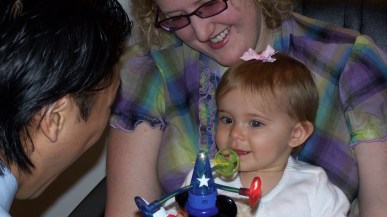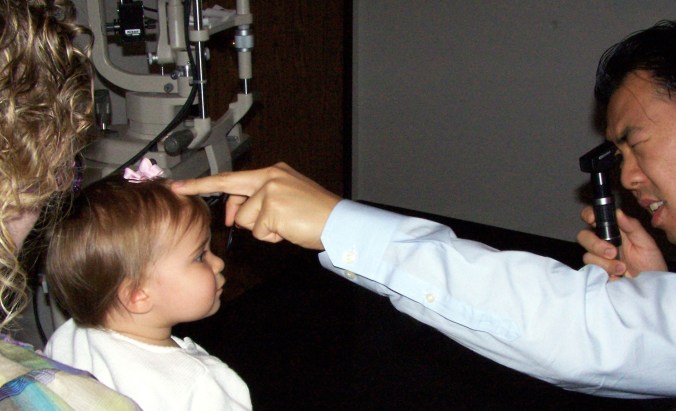Today I want to address something that patients almost never think about. We’re all guilty of this, even in regards to general health. If there’s no aches or pains, there’s no need to see your doctor, right?
WRONG.
When it comes to young children, they don’t naturally know how they should see, so they often will not express any complaints about their vision. And, unless their needed prescription is exceptionally strong, it is hard for a parent to diagnose the need by watching their child’s behavior.
Developmental Delays
If a child is not seeing properly, it can often lead to developmental delays, even before they enter school. If their near vision is not strong enough, they will have difficulty learning to read, or even having a desire to read.

Children can have an initial exam, as young as 12 months old. A child doesn’t have to be able to read, in order to have an exam. There are ways for an eye doctor to test a child’s vision, using dilation. In my experience, unless there is the sign of a problem, I would avoid the first examination between about 18 months and 3 years, as children of that age can be more afraid of the visit, and are harder to keep still in the chair for the exam.
There was a recent study which showed that getting children into glasses as early as they need them can help to improve performance in school and prevent developmental delays.
School Screenings
The vision screenings done by schools, and by pediatricians during a physical, can be useful in spotting larger issues, but they do not test the full breadth of vision and health concerns a complete routine eye exam does.
Even if there are no vision problems, having a baseline exam very early in life can help an eye doctor spot any small changes later in life which could be signs of problems which are developing.

Also, the earlier a child goes in for their first eye exam, and if they continue to be a routine visit, it can help eliminate the fear that children often have of the unknown in a doctor’s office.
Blue Light Concerns
You’ve seen me write about this before, it’s an especially important concern for children. There have been many reports and studies recently discussing the concerns associated with HEV, or Harmful Blue Light. Not all blue light is dangerous, but the light just above Ultraviolet is particular concerning to those of us in the optical field for many reasons.
Much of the reports about the danger to melatonin production, and our ability to sleep properly because of too much blue light exposure is overblown and inconclusive, but there is an aspect of blue light which is less known in popular culture, but much more concerning. Specifically, there have been numerous studies which show a distinct relationship between exposure to HEV and the development of Age-Related Macular Degeneration (AMD) later in life. AMD is loss of vision in the center of the retina, where we have our sharpest vision. AMD is irrerversible. Once Macular Degeneration begins, all we can do is slow it, but it cannot be stopped. The end result of AMD is blindness.
For those of us in our 40’s, this is maybe a slightly lower concern for this eventual blindness because the additional exposure we’re getting from digital devices started relatively late in life, but for our children, they are being exposed at tremendously high rates compared to us basically since birth. Anything we can do to reduce their exposure (let them use the iPad or our phones less) can help, but the best way to help us to get them into protective eyewear for when they use these devices, even if they have no prescription.


There are dozens of lens options on the market now designed to reduce our exposure to HEV. Some do this by dramatically changing the color of the lens to filter out the blue light. Some of these do this in a more subtle way, combining light filtration from No-Glare treatment combined with lens material filtration to reduce exposure, while minimizing how “yellow” the lens appears. For a child, even one with no prescription, I would probably recommend an Eyezen lens, with a no-glare treatment. I find this lens is less yellow and therefore less distracting to a new glasses wearer. And for children, we do have to think about how these lenses might be viewed by their peers and I think they would receive less teasing for a lens that doesn’t appear yellow.
Take Away
Whether you have seen signs of visual issues with your children or not, it is critical that they receive an full routine eye exam at an early age. Even if no eyeglass prescription is found, there are other reasons they should get eyewear to protect their eyes from the harmful blue light emitted by digital devices. This harmful blue light can lead to blindness later in life.
Great article and reminder!
LikeLiked by 1 person
Pingback: Importance of Children’s Eye Exams | THE OPTICAL JEDI: A GUIDE TO THE MYSTERIES OF GLASSES